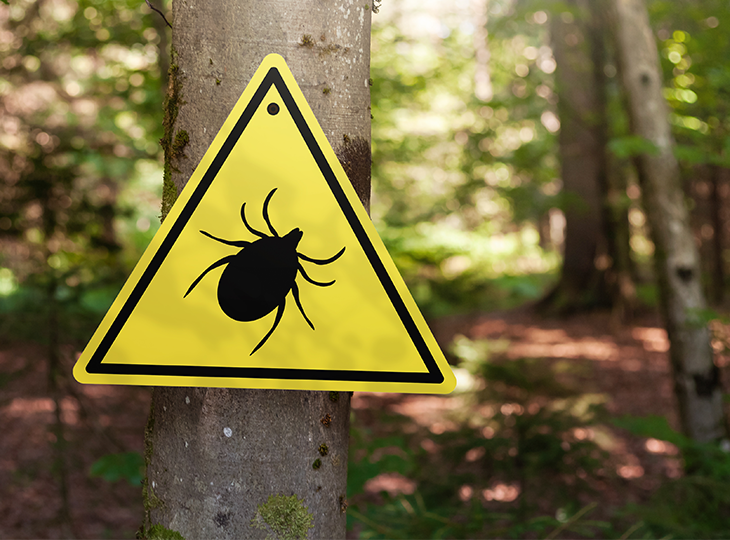Tues: 8:30am - 3:00pm
Wed: 12:00pm - 6:00pm
Thurs: 8:30am - 3:00pm
Fri: Closed
Sat: 8:30am - 12:30pm
Sun: Closed
Greenvale, NY 11548
The Trouble with Ticks


As summer moves inevitably toward autumn, many are planning their last hurrah before the cold weather sets in. If exploring the great outdoors is on your schedule, or just an afternoon working in the garden, be aware that the warming planet is spreading all types of tick-borne illnesses to new places.
As Earth warms on average and winters become milder, ticks are becoming active earlier in the year, extending the length of time they actively feed on humans and animals. They’re nasty, and potentially dangerous.
Anyone can get a tick bite. But people who spend lots of time outdoors in wooded, grassy areas are at a higher risk. Campers, hikers, and people who work outdoors, especially in gardens and parks, are more likely to encounter ticks.
Most tick bites happen in the summer months when the parasites are most active and people spend more time outdoors. But you can get bitten in the warmer months of early fall, or even late winter if temperatures are unusually high. During a mild winter, ticks may come out earlier than usual.
Ticks belong to the same class as spiders, scorpions and mites.
The most commonly affected sites attacked by ticks are the lower limbs (mainly ankles and legs), but ticks are also notorious for dropping from trees, bushes and other vegetation onto the head or arms of a target. Ticks that burrow into the scalp can be especially dangerous because they are harder to see and due to the potential for infection in proximity to the brain.
Visible signs that a tick has latched onto the body include lesions and small papules, as well as the tick itself.
Lyme disease and Rocky Mountain spotted fever are dangerous illnesses common to tick bites.
Lyme disease usually causes symptoms such as a rash, fever, headache, and fatigue. If it is not treated early, the infection can spread to your joints, heart, and nervous system. There is currently no vaccine available to prevent Lyme disease.
Rocky Mountain spotted fever is a bacterial disease spread through the bite of an infected tick. Gone undetected, there is up to a 1 in 4 chance the disease will be fatal, so early diagnosis and treatment is vital.
More recently, the medical community has raised concerns about Alpha-gal syndrome – a tick-bite-associated condition that can make the bitten individual allergic to meat.
The U.S. Centers for Disease Control reports that between 2010 and 2022, there were more than 110,000 suspected cases of alpha-gal syndrome identified.
The Role of Global Warming
Since 1901, the average surface temperature across the contiguous United States has risen at an average rate of 0.17°F per decade. Average temperatures have risen faster since the late 1970s (0.32 to 0.55°F per decade since 1979), according to the Environmental Protection Agency. Even a fraction of a degree of global warming creates more opportunity for ticks to breed and spread disease.
Public health officials are particularly concerned about tick-borne encephalitis, a deadlier disease than Lyme.
The reason for this uptick in parasitic activity is simple.
Ticks can’t survive more than a couple of days in temperatures below zero, but they’re able to survive in very warm conditions as long as there’s enough humidity. As Earth warms on average and winters become milder, ticks are becoming active earlier in the year. Climate change affects ticks at every stage of their life cycle — egg, six-legged larva, eight-legged nymph, and on to adult — by extending the length of time ticks actively feed on humans and animals.
Preventative Measures
- Stay on footpaths and avoid long grass when out walking
- Wear a long-sleeved shirt
- Tuck your pants into your socks
- Wear light-colored clothes (making it easier to spot a tick)
- Use insect repellent
- Check yourself for ticks and remove any at once
- Check your children and pets for ticks
How to Remove a Tick
The American Academy of Dermatology recommends these tips for removing a tick that is attached to your skin:
- Use tweezers. Sterilize the tip of the tweezers using rubbing alcohol and grasp the tick as close to the skin’s surface as possible.
- Pull upward with steady, even pressure. Avoid twisting, squeezing or crushing the tick, as this can cause its head or mouth to break off and remain in your skin, potentially causing infection. If this happens, use tweezers to remove the remaining parts. If you cannot remove the rest of the tick, see a board-certified dermatologist.
- Place it in a sealed bag or container; submerse the tick in alcohol; or wrap it tightly in tape. You may also want to save the tick in a sealed jar. That way, if you develop any symptoms after the bite, the tick can be tested for disease.
- Clean the bite area with soap and water.
When to See a Board-Certified Dermatologist
If you begin to experience symptoms known to be related to tick bites – whether or not you’ve found a tick on your skin – it’s probably time to see your dermatologist. Symptoms such as a rash, fever or body aches are common. Make sure you tell your dermatologist about your recent tick bite, when it occurred and where you most likely acquired the tick.
Your dermatologist will examine the bite mark and determine if any parts of the tick are still attached or embedded in your skin. Unlike a mosquito, which attacks with a single stab of its proboscis to extract blood like a hypodermic needle, the tick is much more nefarious. Ticks dig in using two sets of hooks. Each set looks like a hand with three hooked fingers. The hooks dig in and wriggle into the skin. This is why it’s hard to remove an entire tick intact. Either set of hooks may be torn off and left embedded in the skin, or even an individual hook, which is still sufficient to cause infection and transmit disease.
See your dermatologist right away if you experience any tick-related symptoms. As with any disease, an illness related to a tick bite responds best to treatment when caught early.
Let Walk-in Dermatology Take Care of You
If you have concerns about a tick bite or any skin condition and need dependable answers – fast – you don’t have to wonder, worry or wait. Walk-in Dermatology is here to keep you healthy. Our team of dermatologists and experienced healthcare staff will address your concerns and provide the necessary care for all your skin conditions. Contact us today (516) 621-1982.








